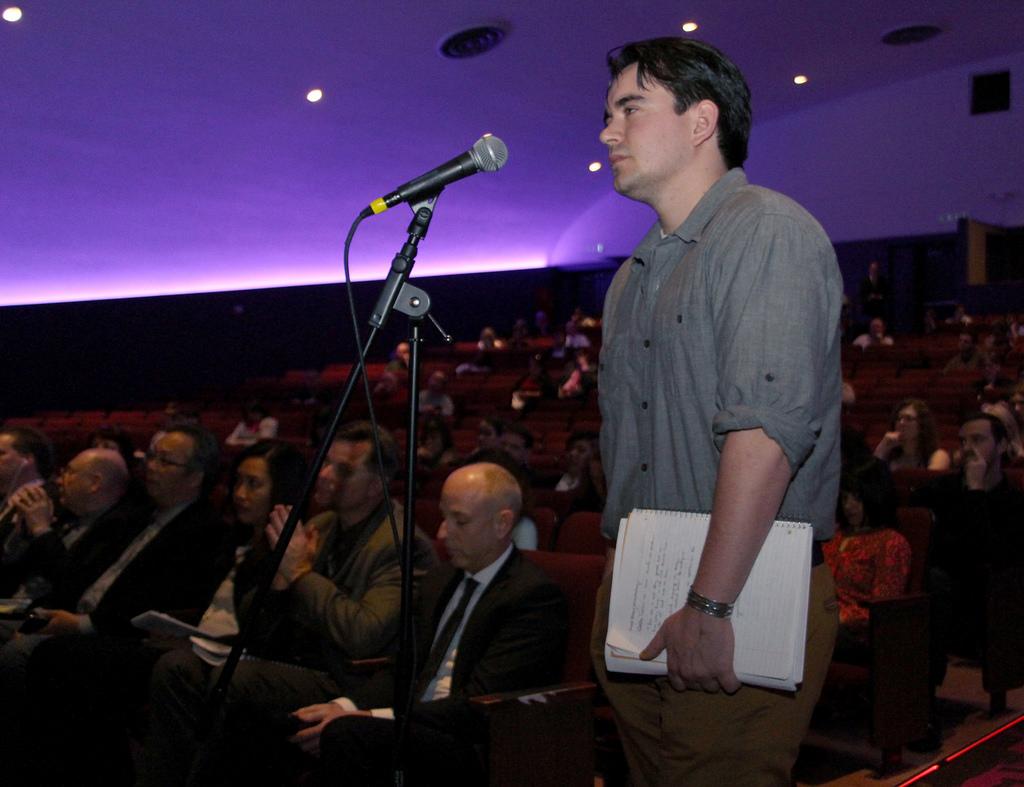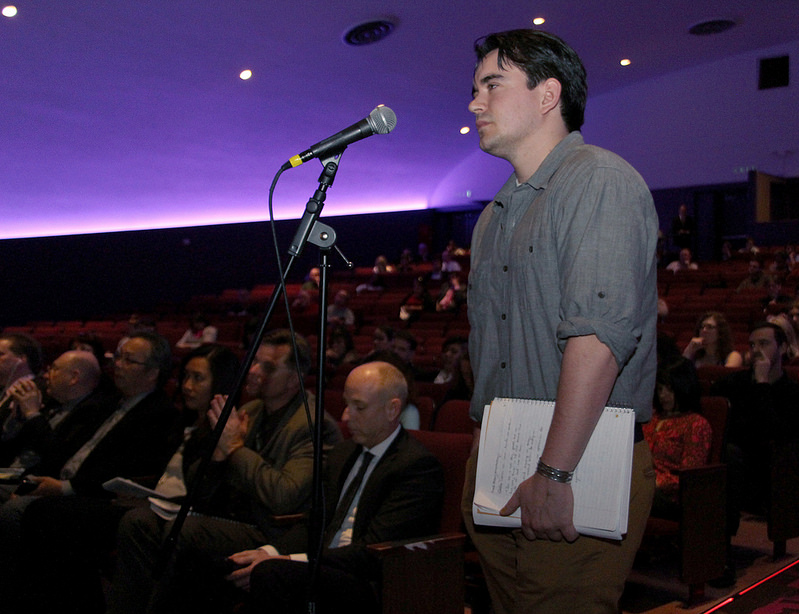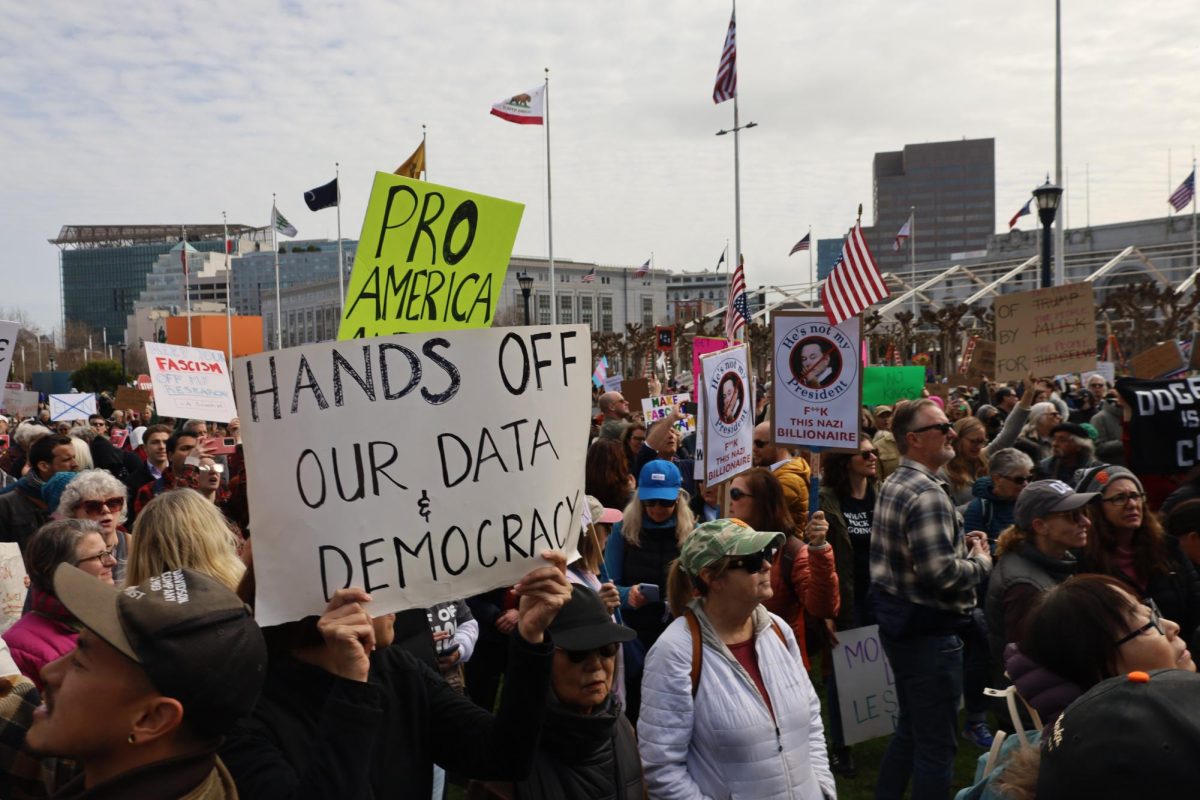 Michael Buelna, a Zoology major, asks a question to the speakers at the town hall meeting on the science building closure, in SF State’s McKenna Theatre, Feb. 13, 2014. Buelna has had a few classes in the science building.
Michael Buelna, a Zoology major, asks a question to the speakers at the town hall meeting on the science building closure, in SF State’s McKenna Theatre, Feb. 13, 2014. Buelna has had a few classes in the science building.
Photo by Gavin McIntyre / Xpress
SF State held a town hall meeting Feb. 13 to update students, faculty and staff on the closure of the Science Building. Two experts said the health risks to those who have been in the building is minimal.
The crowd at the nearly half-full McKenna Theatre breathed a sigh of relief when Patricia Beach announced that the chemical levels did not pose a health risk. Beach is the managing partner and senior scientist at Harris & Lee Environmental Sciences, the organization hired to assess the building’s health risks.
The findings are based on a report released Feb. 11, which concluded that the levels of airborne asbestos, mercury and lead in the Science Building are too low to pose a significant danger to health.
“Given that we’re not seeing the material in the air, the adverse health impacts are unlikely to occur for people attending class, visiting or working in the Science Building,” said Beach.
The consultants conducted testing by mimicking what it would be like to work inside the Science Building, which found that routine exposure to surfaces and objects in the building resulted in no discovery of airborne contaminant dust.
The contaminants would have needed to be in the air in order for significant exposure to occur, according to Beach. They would also have to get into someone’s body to cause harm, meaning that someone would have to inhale it, absorb it through their skin or ingest it.
The contaminants can have serious health effects, but won’t in this case because of the low levels of the contaminants on the surfaces, according to Michael Fischman, a clinical professor of medicine at the University of California, San Francisco.
“It’s not going to be helpful in terms of understanding if you have a health problem now or are at risk for a health problem down the line,” said Fischman.
For those who were concerned that the contaminants on the surface may have rubbed against their clothing, Fischman said that it’s not likely to cause a health problem. He added that there isn’t a need for medical testing and that he doesn’t encourage people to do it because of the low levels of the contaminants.
[HTML2]
Courtesy of San Francisco State University
SF State President Leslie E. Wong said that the building is closed as a safety precaution to students and faculty.
“We took the concern seriously as you’re hearing,” Wong said. “We tried to work expeditiously and openly and transparently.”
Wong said that his first strategy was to seal off the building into thirds so that the remediation team could work on sections at a time and progress forward. He added that this strategy could not work because the team would be wearing hazmat suits and would be in close distance to students and faculty walking into the clean side of the building.
Despite this, the Science Building will continue to be closed throughout the clean-up process, according to Ron Cortez, vice president for administration and finance and CFO.
“There are two reasons for the closure,” said Cortez. “Concerns about health and safety and concerns about our ability to continue to remove (the chemicals).”
Marketing professor Bruce Robertson, one of the 250 faculty and staff displaced by the closure, expressed the frustration experienced by professors who were ordered to leave their offices in the building.
“They said ‘take everything you need.’ We have to wait until March to create a work space. I’m carrying my office with me,” said Robertson, holding up a backpack.
Several other faculty members brought up their concerns at the meeting, including the inability to do research and concerns about the fate of rare Native American artifacts that are in the building.
Several similar buildings will be tested starting this week. This concerned some students and faculty already suffering from the closure of the Science Building.
“I don’t think any of us want another building to be closed down,” said Junior Student Representative Cain Buckler, speaking on behalf of the 6,000 students who have suffered from hastily reshuffled and for two sections, cancelled classes.
Other SF State buildings that will be tested for chemicals include the Business Building, Creative and Fine Arts buildings, HSS Building, and the gym.
There are no plans to close these buildings during testing, according to Wong.
[HTML1]







